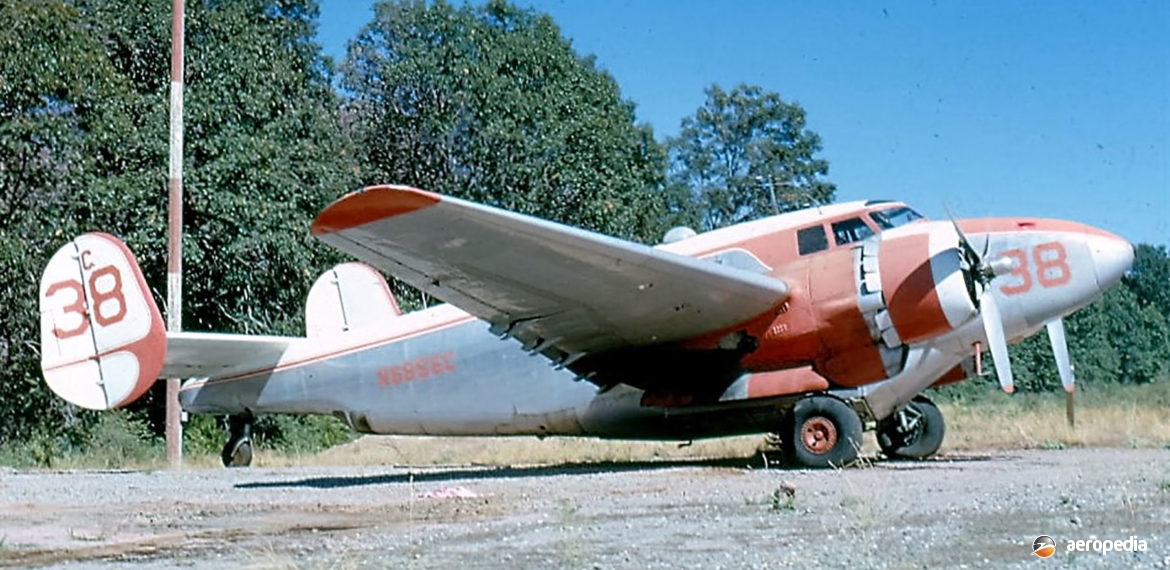Photograph:
Lockheed PV-2 Harpoon N6858C (c/n 151201) in the United States in September 1968 (Eric S Favelle)
Country of origin:
United States of America
Description:
Twin-engine maritime patrol bomber
Power Plant:
Two 1,492 kw (2,000 hp) Pratt & Whitney R2800-31 Double Wasp eighteen-cylinder two-row radial air-cooled engines
Specifications:
- Wingspan: 22.86 m (75 ft 11¾ in)
- Length: 15.88 m (52 ft 1½ in)
- Height: 4.05 m (13 ft 3 in)
- Wing area: 51.65 m² (556 sq ft)
- Max speed at 4,633 m (15,200 ft): 497 km/h (309 mph)
- Cruising speed: 253 km/h (157 mph)
- Normal range: 2,880 km (1,790 miles)
- Max range: 4,659 km (2,895 miles)
- Empty weight: 9,149 kg (20,170 lb)
- Loaded weight: 13,293 kg (29,305 lb)
Armament:
Five fixed forward firing 12.7 mm (0.50 in) machine guns in nose; two 12.7 mm (0.5 in) machine guns in dorsal turret and ventral tunnel. Max bomb load 1,814 kg (4,000 lb)
History:
Following the success of the PV-1 Ventura, the chief engineer of Lockheed Vega commenced work on development of a new variant to meet US Navy requirements, this model, the PV-2 Harpoon, having an increased wingspan, a re-designed tail, an increase in fuel capacity and an increase in all up weight. The changes meant the Harpoon with the R-2800 engines had the maximum speed reduced by 32 to 48 km/h (20 to 30 mph) but, despite being slower than the Ventura, its handling qualities, especially single-engine performance, were improved.
On 30 June 1943 Lockheed received a contract to build 500 Harpoons (a total of 535 examples being completed), the prototype flying for the first time in November 1943 at Burbank, California, production commencing in March 1944. First units to receive the type were VPB-139 in the Aleutian Islands, and VPB-142 on Tinian. Early production aircraft became known as the PV-2C and were used by training units due to spar problems and difficulties experienced with the outer wing self sealing fuel tanks. The PV-2D had eight machine guns mounted in the nose and 35 had been completed when contracts were cancelled at the end of the war.
The type saw service with US Navy units, carrying out rocket and bombing attacks in the Kurile Islands. On 27 June 1945 a Harpoon of VPB-142 sank a Japanese submarine it found on the surface in the vicinity of the Truk Islands. By the end of the war nearly half of the US Navy Patrol Squadrons were operating the Harpoon. Later the type was run down and used by Reserve Squadrons, eventually being replaced by the Lockheed Neptune from 1947.
Only sale of the type was to the Brazilian Navy, but Portugal, France, Holland, South Africa and Japan received surplus Harpoons under the Foreign Military Assistance Programme. A few examples survive in museums, and a couple are airworthy in the United States. After the war a number were converted for civil use, some being used for fire fighting and converted as borate bombers. Oakland Airmotive Co of Oakland, California converted a number to the Oakland Centaurus, a high-speed executive transport conversion with accommodation for 8 to 14 passengers.
Although the type was operated in this region by United States forces late in World War II, none came into the hands of the RAAF. However, four were supplied in 1945 to the RNZAF under lend-lease arrangements. Intended to replace the PV-1 / B-34 Ventura in service, only four examples were received of the 47 initially allotted, and these were: NZ4701 (c/n 15-1051 – BuA 37085); NZ4702 (c/n 15-1048 – BuA 37082); NZ4703 (c/n 15-1049 – BuA 37084); and NZ4704 (c/n 15-1050 – BuA 37084). The aircraft were delivered to the US Navy on Hawaii and assembled on Ohau.
The aircraft were flown to New Zealand, the first three in March 1945 and the 4th the following month. They were taken on charge by Unit 83 at Rukuhia. They were operated for only a short time and then were returned to the US Navy, records indicating they were returned between December 1944 and June 1945. They were painted in, and had, a US Navy colour scheme, RNZAF markings being applied over the US Navy markings, and carried RNZAF serials. One is believed to have been on Guadalcanal in May 1944.

